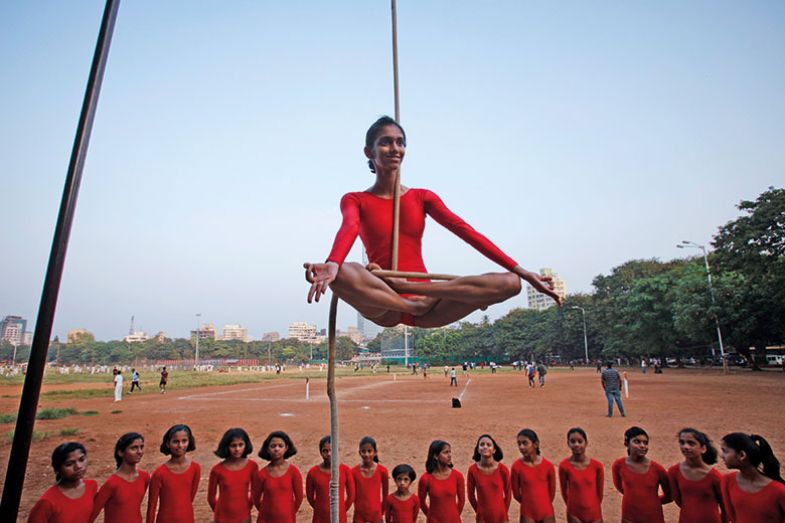The spread of education in society provides the foundations of success in countries that are latecomers to development. Primary education creates the base. Equal opportunities in school education are critical. Higher education, then, imparts the cutting edge. In every sphere, India is now a laggard in Asia.
There is a quiet crisis in higher education in India that runs deep. There are too few educational opportunities for school-leavers and those that exist are not good enough. The pockets of excellence are outcomes of the enormous reservoir of talent and Darwinian selection processes. Institutions and individuals can excel, but this is despite the system, which is just not conducive to learning and does little for those with average abilities or without social opportunities.
The challenges confronting higher education in India are clear. It needs a massive expansion to educate much larger numbers, but without diluting academic standards (indeed, it is just as important to raise the average quality). It needs to be far more inclusive. And it needs some institutions that are exemplars of excellence, on a par with the best in the world.
Such excellence is currently missing. Indeed, judged by its performance in Times Higher Education’s World University Rankings – which are as good as it gets – India’s performance in recent years has been dismal. It must be said that these rankings have all the limitations of composite index numbers, since it is difficult to measure qualitative attributes while weights assigned to different components shape results. Even so, it is obvious that India’s universities have miles to go before reaching world standards. Islands of excellence – Indian Institutes of Technology (IITs), Management (IIMs) and Science (IIScs) – are no consolation because the lifeblood of higher education is not small, elite institutes but universities providing educational opportunities for people at large.
Alas, the comparative advantage that India once had – at least in a few of its universities – has been slowly, yet surely, squandered over time. Universities have deteriorated in India but improved elsewhere, particularly in Asia. This would be very clear if there were rankings for 1985.
Even the little that remains of excellence in Indian universities is being progressively undermined by the growing intrusion of party politics in the way universities are run and academics appointed and promoted. Such processes are almost irreversible because there are long-term consequences of short-term political interventions. Physicists would describe it as hysteresis.
There is intense competition among Indian students for admissions to public universities with standards and reputations. The fortunate few who do well enough in the school-leavers’ Class XII examinations take up these limited places, while most students make do with institutions in the private sector, where fees are always high but quality is often poor. Only the privileged few have parents rich enough to send them abroad instead – although, in terms of student numbers, that has increased from roughly 50,000 in 2000 to 200,000 in 2010 and 350,000 in 2015. If their average expenditure on fees and maintenance is $25,000 per student per annum, Indian students overseas are now spending about $9 billion (£6.7 billion) every year. If this sum were made available for higher education in India, it could help transform at least some universities.

Indian higher education is caught in a pincer movement. On the one hand, there is a belief that markets can solve the problems through private players, which is leading to education-as-business, shutting the door on large numbers of students who cannot finance themselves while failing to institute the regulation that would ensure quality. On the other hand, Indian politicians and officials of all stripes are virtual control freaks with respect to public universities, motivated by their desire to exercise political influence for reasons of patronage, ideology, rent-seeking or vested interest. Such micro-management, carried out by both central and state governments, accentuates problems, strangling autonomy and stifling creativity without creating any accountability. The quality of education is collateral damage. There is a progressive dilution of academic standards when belief systems and rewards systems in political processes replace academic pursuits and excellence as the primary focus of university communities.
Political intrusion in universities is not new. It began almost five decades ago, but it has gathered momentum in the past 25 years, and has now reached a stage that could be the edge of the precipice for public universities in India.
In the late 1960s, state governments saw an opportunity to dispense patronage by appointing political favourites to both academic (including vice-chancellorships) and non-academic positions in universities. Ruling parties also recognised an opportunity to extend their spheres of political influence. Unions of students, teachers and employees became instruments in political battles.
It was not long before the central government acted on a similar rationale regarding the so-called central universities, which it directly oversees. The turning point, perhaps, was 1977, the end of the era of majority governments and one-party rule. It gathered momentum after 1989, when India was governed by a succession of short-lived coalitions. The competitive politics unleashed by frequent changes in governments soon spilled over into universities, not only as spheres of influence but also as arenas for political contests, involving a significant proportion of both faculty and staff with different party political affiliations. The discomfiture with independent or critical voices grew rapidly, even though they were very few.
The double standards in all this are striking. When in government, parties invoke public interest as a justification for interfering with universities. But when in opposition the same parties wax eloquent about institutional autonomy and freedom. The decline of public universities in India has been an inevitable consequence. Every government laments the absence of world-class institutions, without realising that it is attributable in part to their interventions and to the growing intrusion of political processes. It takes years – even decades – to build institutions. But it takes much less time to damage them. We are simply mortgaging the future of public universities in India.
It needs to be stressed that the blame for this cannot be laid at the door of politics and governments alone. Universities as communities, and as institutions, are just as much to blame. The quality of university leadership has declined rapidly, in part because of partisan political appointments of vice-chancellors who are simply not good enough as academics or administrators, and in part because most vice-chancellors do not have the courage and the integrity to stand up to governments, often because they have an eye on the next job they might get. But the professoriate is mostly either complicit, as part of the political process in teachers’ unions, or just silent, preferring to look the other way and concentrate on their narrow academic pursuits. Those who take a stand against politically tainted incompetence are all too few. Even the students are either caught up in the same unions – which function as nurseries for political parties – or opt out to concentrate on their academic tasks.
For university communities, it is imperative to recognise that such compromises are self-destructive as acts of commission – while opting out is just as blameworthy an act of omission. If universities want autonomy, it will not be conferred on them by benevolent governments. They will have to claim it.
The University Grants Commission (UGC) is also part of the problem. Its combined remit to oversee university licensing, regulation and funding, unique across the world, allows it to exercise enormous control at political behest. Moreover, its belief that one-size-must-fit-all drives a fetish for standardisation, whether that be in curricula, appointments, promotions, salaries, evaluation, administration or institutional architecture. The outcome is that every university must move at the speed of the slowest, if not drop to the quality of the lowest. Economists describe this as the convoy problem. Such levelling stifles diversity, pluralism and institutional differentiation, all of which are necessary to develop academic excellence.

The problems with the Indian higher education system are widely recognised, but while the quest for excellence is long on words, it has been short on substance. Several committees have submitted reports, and there are blueprints galore, but most just gather dust on government shelves.
One suggested solution has been to open up the Indian market to branch campuses of overseas universities. The previous government had pinned its hopes on this strategy, but we must remember that universities are much like organisms that evolve, mature and grow over time. It is very difficult to transplant them successfully; experience from elsewhere suggests that overseas campuses never match the quality of the parent.
Both the present and the previous governments are enthusiastic about multiplying the number of IITs, IIMs and IIScs, but the inevitable outcome of that would be a dilution of the brand of those existing institutions that have already attained academic excellence.
The present government announced its preferred solution two years ago. The Institutes of Eminence initiative is meant to see the creation of an enabling regulatory structure for 10 public and 10 private universities, in the hope that they will emerge as world-class teaching and research institutions. The 10 public universities, to be announced shortly on the basis of specified criteria, will each receive 5 billion rupees (£56 million) over five years.
It is never too late for such an initiative, but, as currently specified, it does not do nearly enough. It needs much higher funding and far deeper institutional change to eliminate the systemic flaws that have curbed if not stifled excellence.
It is essential that the contemplated regulatory structure provide complete autonomy – administrative, financial and academic – to the Institutes of Eminence. Liberation from the shackles of UGC is a necessary condition. The existing parliamentary or legislative acts that created the public universities also impose many constraints and fetters. The solution might lie in altogether new enabling legislation for what could be described as national universities, providing them with institutional autonomy and eliminating structural rigidities.
Even then, however, such legacy institutions would still carry dead wood, baggage and inertia, so it might also be worth establishing at least one new national university from scratch, with a mandate for excellence. This would be expensive and time-consuming – it takes at least a decade for a new university to establish itself – but it would be worth it to create a role model.
National universities, in turn, could mentor other institutions. They must not be large; the optimum size would be in the range of 5,000-10,000 students. They should span a wide range of disciplines across languages, humanities, social sciences, physical sciences, life sciences and earth sciences, while recognising that knowledge often develops at the intersection of disciplines. They should have state-of-the art infrastructures, laboratories and libraries. Faculty members should teach both undergraduate and postgraduate students. The teaching should be in English because translations limit access to academic texts, which are invariably in English. And there should be a special emphasis on attracting international students.
Structures of governance must be innovative. It must be ensured that, when it comes to decision making, supporting governments, corporate entities and philanthropists are all kept at arm’s length. The best model would be a board of governors, to which governments or promoters could nominate at most one-third of the total number of members. The others should be independent, with half being distinguished academics and the other half drawn from industry, civil society or the professions.
The chairman should also be an eminent academic, with administrative experience. Members of the board should have a fixed term of six years, with a third of them retiring every two years. Except for nominees of governments or promoters, replacements should be selected by the board. The vice-chancellor should also be appointed by the governors with a six-year tenure, and should be an ex officio member of the board.
Financial autonomy is just as important. Institutes of Eminence should have the freedom to set their own student fee levels. The government should also consider doubling its special grant-in-aid for five years to 10 billion rupees and providing each Institute of Eminence with a one-time-start-up endowment of 100 billion rupees. This would assure financial autonomy over time – especially if the universities were also able to top up that fund with resources from industry, philanthropists or alumni networks. They should be allowed to invest their funds in financial instruments of their choice, by employing portfolio managers if required. Income tax laws could be amended to encourage contributions to, and accumulation of, such endowments.
Academic decisions about faculty, curriculum, admissions, examinations and evaluation should be the prerogative of the university as an institution, subject only to due process. Institutes of Eminence should have complete freedom to appoint and remunerate faculty members; flexibility in salary levels, both within and between universities, is necessary to attract and to retain talent.
Admissions of undergraduate and postgraduate students could be based on performance in a national entrance test, combined with results in Class XII and undergraduate exams respectively. But all admissions must be needs-blind, so that once a student is admitted, financial support is assured.
These universities and their departments should also have complete freedom in deciding upon their curricula, examination and assessment methods. Academic freedom is primary because universities are places for raising doubts and asking questions about everything. Exploring ideas, debating issues and thinking independently are essential in the quest for excellence, and allow universities to fulfil their necessary function as the conscience-keepers of the economy, polity and society.

This autonomy must have a corresponding accountability. But it is essential for governments to recognise that the provision of resources to universities does not endow them with a right to exercise control. The resources are public money for public universities, which are accountable to students and society through institutional mechanisms that already exist or can be created. Students, for instance, should evaluate the courses taught to them, and this feedback should be institutionalised. Both teaching and research should be subject to periodic peer reviews.
For this purpose, it is imperative that structures of governance in universities are appropriate for, and conducive to, accountability. Good governance is necessary but not sufficient. There must also be checks and balances in the public domain. Despite their limitations, rankings of universities perform an important role in this context, providing students, their parents and society at large with a measure of institutional quality.
All this, I recognise, is easier said than done. Yet, we must remember that it has been done elsewhere. It needs political will, changed mindsets, and a belief that a better world is possible.
Deepak Nayyar is emeritus professor of economics at Jawaharlal Nehru University, New Delhi and an honorary fellow of Balliol College, Oxford. He served as vice-chancellor of the University of Delhi from 2000 to 2005.
POSTSCRIPT:
Print headline: Believe in better
Register to continue
Why register?
- Registration is free and only takes a moment
- Once registered, you can read 3 articles a month
- Sign up for our newsletter
Subscribe
Or subscribe for unlimited access to:
- Unlimited access to news, views, insights & reviews
- Digital editions
- Digital access to THE’s university and college rankings analysis
Already registered or a current subscriber? Login







